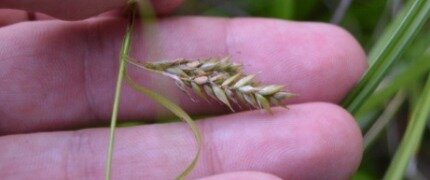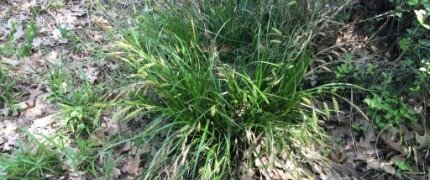Cherokee Sedge
A fantastic native grass to plant in Chattanooga!
© obrock, some rights reserved (CC-BY-NC)
Cherokee sedge (Carex cherokeensis) is a perennial member of the grass group of plants. It is a native plant to the southeastern and southcentral portions of North America. Both its common name and its species epithet are an honor to the Native American tribe, the Cherokees.
Physical Description
This species grows to a height of 12” to 18” tall and 12” to 18” wide. While this is a flowering plant, its reproductive structure is rather inconspicuous. The portion of the plant holding the seeds is a dull, light brown color and the seeds themselves are brown, yellow, or green. The plant has an evergreen appearance and 16” drooping, narrow, grass-like leaves. The plant has a spreading form and will colonize adjacent areas but it is not considered aggressive. It is a rather slow-growing and low-maintenance, well-behaved plant.
Habitat
The Cherokee sedge prefers moist, loamy soils that have a rather high calcium content such as bottomland forests, mesic forests, and wet meadows. These plants are a wonderful ground cover and, as such, can be used to hide all sorts of yard problem areas as well as for accenting showy sites.
This sedge forms attractive, slowly-spreading clumps (6-12” tall) of fine-textured, narrow, grass-like, deep green leaves. It is grown in the landscape for its foliage effect. Greenish-white flowers in spring are inconspicuous. Wheat-like seed spikes mature in autumn.
Landscape Value
By Matt Whitaker of WMWA Landscape Architects
Cherokee Sedge is one of our 160 plus US native sedges with around 140 native to the east. Its native range radiates out from the southern half of the Mississippi River and covers most of the southeast. We’re close to the northern edge of its most common range, but I see it regularly here including along the Virginia Avenue Greenway. With so many species of sedges this is one of the few that are distinct enough to visually identify with ease. Typically 12 to 18-inches tall, Cherokee sedge is a great garden addition in mass or even as a specimen in a larger perennials planting. It is mostly evergreen and more tolerant of normal soils and sun than many other sedges but will do best in part sun or full shade and uniform moisture. Like so many plants, you put it in more sun if it has more water. It has an attractive form with arching blades to form a medium fine clump. Upright “bloom” stems in the spring transition to dangling clumps of seeds in the summer and fall. It slowly spreads in place and will reseed lightly. Maintenance is low with only a trim back to 4-6” in late winter before new foliage starts to emerge. I have used it effectively in rain gardens and to control erosion on slopes. It is dense enough that few weeds can get through it.
Photo 2179471, (c) Matthew Herron, some rights reserved (CC BY-NC); photo 6741183, (c) Alysa Joaquin, some rights reserved (CC BY-NC); photo (c) Hubert Matthews, some rights reserved (CC BY-NC)
Uses
The primary use for this type of grass is as a ground cover. Therefore, it is often found as a stop for erosion in sloping terrain, so common here in the Chattanooga area.
Cherokee sedge is also used in more formal gardens as an inflection point when the eye proceeds from one textural area to another.
Protection Status
This species is not considered protected by any federal or international agency.
Interesting Information
Some gardeners have indicated that the Cherokee sedge is a perfect plant for the backyard because it requires such low maintenance. Additionally, heaping on fertilizer and soil amendments tends to reduce the growth of this grass. After any minor maintenance in the early spring – light clipping of the leaves to maintain shape and a weak organic fertilizer – it's best to just leave this plant to itself.
This species is heat and drought resistant as well as deer resistant. It prefers medium moisture but can continue with lots of water or very little water for short periods. It does best in medium sunshine but will grow well in shade or full sun for short periods.
The US Army has designated this plant as a facultative wetland species, meaning that it prefers a wetland habitat but will grow well in non-wetland areas.





